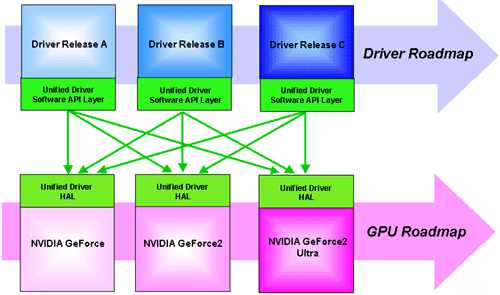NVIDIA's Detonator3 Drivers - Teaching an "old" dog new tricks
by Anand Lal Shimpi on August 14, 2000 9:00 AM EST- Posted in
- GPUs
NVIDIA's Unified Driver Architecture

We've all heard of NVIDIA's "Unified Driver Architecture" (UDA) and we've all experienced what it enables us to do as end users. For those of you that aren't familiar with it, basically what the above picture is demonstrating is that on every chip NVIDIA releases they have a small portion of silicon that is indicated by the green Unified Driver Hardware Application Layer (HAL) on each GPU (GeForce, GeForce2, GeForce2 Ultra). At the same time, each driver release contains code that interfaces directly with that Unified Driver HAL, so even before the GeForce2 Ultra was out, NVIDIA had drivers that could run the chip.
According to NVIDIA, this allows them to stick to their 6-month product cycles since very little time has to be spent developing drivers. Of course individual optimizations are made later on to get the most performance out of each chip, but as far as getting reliable, fully functional drivers for a brand new graphics chipset, NVIDIA's UDA allows them to do so with very little effort.
At the same time you'll have to remember that the past three graphics chipset releases from NVIDIA (including the GeForce2 Ultra) haven't been all that different from one another so making the drivers adapt for use with each product release shouldn't be that difficult. The NV20 should pose an interesting problem for NVIDIA as it may include some new rendering techniques that are obviously not currently supported in the current Detonator drivers but if they stick to their UDA they should be able to, at least according to them, have working drivers for the NV20 even before the chip is taped out.










0 Comments
View All Comments